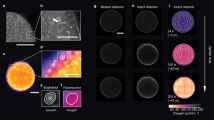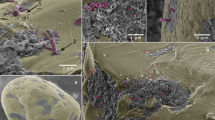Abstract
Spherical (~2 mm diameter) diatom (Skeletonema sp.) aggregates, representing analogues of “marine snow”, were placed at the sediment–water interface of an experimental sediment system. Optode measurements showed that, after an initial lag period, oxygen concentrations within the aggregates decreased and then were gradually replenished, resulting in a temporary anoxic microniche. A multi-species, 3-dimensional, reactive transport model was used to simulate the oxygen dynamics and the associated biogeochemical consequences. Temporal and spatial changes in oxygen were replicated assuming an exponential increase in the mineralisation rate constant and a gradual exhaustion of reactive organic material. The peak value of the time-dependent reaction rate constant of organic matter mineralisation (k OMM) was seven to sixty times greater than analogous values measured previously in water column experiments. The validated model was used to investigate how the size and reactivity of parcels of organic matter influence the formation of anoxic microniches at the sediment–water interface of typical deep-sea environments. As well as k OMM, the concentration of reactive organic matter in the aggregate, its size and porosity were also critical in determining the likelihood of anoxic microniche formation. For the optimum fitted parameters describing k OMM and the concentration of reactive organic matter, the minimum diameter of the parcel to induce anoxia was 1.8 mm, whereas it was 2.8 mm to make a significant contribution to the denitrification occurring in a typical deep-sea sediment. This work suggests that anoxic microniches resulting from the settlement of marine aggregates may play an overlooked role for denitrification activities in deep-sea sediments.








Similar content being viewed by others
References
Alldredge AL (1998) The carbon, nitrogen and mass content of marine snow as a function of aggregate size. Deep Sea Res 45:529–541
Alldredge AL (2000) Interstitial dissolved organic carbon (DOC) concentrations within sinking marine aggregates and their potential contribution to carbon flux. Limnol Oceanogr 45(6):1245–1253
Alldredge AL, Gottschalk CC (1988) Direct observations of mass flocculation of diatom blooms: characteristics, settling velocities and formation of diatom aggregates. Deep Sea Res 36:159–171
Berg P, Rysgaard S, Thamdrup B (2003) Dynamic modeling of early diagenesis and nutrient cycling. A case study of an arctic marine sediment. Am J Sci 303:905–955
Billet DSM, Lampitt RS, Rice AL, Mantoura RFC (1983) Seasonal sedimentation of phytoplankton to the deep-sea benthos. Nature 302:520–522
Boetius A et al (2013) Export of algal biomass from the melting Arctic Sea ice. Science 339:1430–1432
Brandes JA (2002) A global marine-fixed nitrogen isotopic budget: implications for Holocene nitrogen cycling. Glob Biogeochem Cycles 16:1120
Brandes JA, Devol AH (1995) Simultaneous nitrate and oxygen respiration in coastal sediments: evidence for discrete diagenesis. J Mar Res 53:771–797
Burdige DJ (2006) Geochemistry of marine sediments. Princeton University Press, Princeton
Carlsson MS, Glud RN, Petersen JK (2010) Degradation of mussel (Mytilus edulis) fecal pellets released from hanging long-lines upon sinking and after settling at the sediment. Can J Fish Aquat Sci 67:1376–1387
Dedieu K, Rabouille C, Thouzeau G, Jean F, Chauvaud L, Clavier J, Mesnage V, Ogier S (2007) Benthic O2 distribution and dynamics in a Mediterranen lagoon (Thau, France): an in situ microelectrode study. Estuar Coast Shelf Sci 72:393–405
Deutsch C, Sigman DM, Thunell RC, Meckler AN, Haug GH (2004) Isotopic constraints on glacial/interglacial changes in the oceanic nitrogen budget. Glob Biogeochem Cycles 18:GB4012
Emery KO, Rittenberg SC (1952) Early diagenesis of California basin sediments in relation to origin of oil. Bull Am Assoc Petrol Geol 38:735–806
Fenchel T, Glud RN (2000) Benthic primary production and O2–CO2 dynamics in a shallow-water sediment: spatial and temporal heterogeneity. Ophelia 53:159–171
Fennel K et al (2009) Modeling denitrification in aquatic sediments. Biogeochemistry 93:159–178
Fossing H, Berg P, Thamdrup B, Rysgaard S, Sørensen HM, Nielsen K (2004) A model set-up for an oxygen and nutrient flux model for Aarhus Bay (Denmark), NERI technical report no. 483. National Environmental Research Institute, Denmark
Fowler SW, Knauer GA (1986) Role of large particles in the transport of elements and organic compounds through the oceanic water column. Prog Oceanogr 16:147–194
Froelich PN et al (1979) Early oxidation of organic-matter in pelagic sediments of the eastern equatorial Atlantic—suboxic diagenesis. Geochim Cosmochim Acta 43:1075–1090
Glud RN (2008) Oxygen dynamics of marine sediments. Mar Biol Res 4:243–289
Glud RN, Jensen K, Revsbech NP (1995) Diffusivity in suficial sediments and benthic mats determined by use of a combined N2O–O2 microsensor. Geochim Cosmochim Acta 59(2):231–237
Glud RN, Ramsing NB, Gundersen JK, Klimant I (1996) Planar optrodes: a new tool for fine scale measurements of two-dimensional O2 distribution in benthic communities. Mar Ecol Prog Ser 140:217–226
Glud RN, Gundersen JK, Holby O (1999) Benthic in situ respiration in the upwelling area off central Chile. Mar Ecol Prog Ser 186:9–18
Glud RN, Stahl H, Berg P, Wenzhofer F, Oguri K, Kitazato H (2009) In situ microscale variation in distribution and consumption of O2: a case study from a deep ocean margin sediment (Sagami Bay, Japan). Limnol Oceanogr 54:1–12
Guillard RRL (1975) Culture of phytoplankton for feeding marine invertebrates. In: Smith WL, Chanley MH (eds) Culture of marine invertebrate animals. Plenum Press, New York, pp 29–60
Hartmann P, Zigler W, Holst G, Lübbers DW (1997) Oxygen flux fluorescence lifetime imaging. Sens Actuat 39:110–115
Holst G, Grunwald B (2001) Luminescence lifetime imaging with transparent oxygen optodes. Sens Actuat 75:78–90
Iversen MH, Ploug H (2010) Ballast minerals and the sinking carbon flux in the ocean: carbon-specific respiration rates and sinking velocity of marine snow aggregates. Biogeosciences 7:2613–2624
Jahnke RA (1985) A model of microenvironments in deep-sea sediments: formation and effects on porewater profiles. Limnol Oceanogr 30:956–965
Jansen S, Bathmann U (2007) Algae viability within copepod faecal pellets: evidence from microscopic examinations. Mar Ecol Prog Ser 337:145–153
Jørgensen BB (1977) Bacterial sulfate reduction within reduced microniches of oxidized marine sediments. Mar Biol 41:7–17
Jørgensen BB, Bang M, Blackburn TH (1990) Anaerobic mineralization in marine sediments from the Baltic Sea-North Sea transition. Mar Ecol Prog Ser 59:39–54
Kamp A, de Beer D, Nitsch JL, Lavik G, Stief P (2011) Diatoms respire nitrate to survive dark and anoxic conditions. Proc Natl Acad Sci USA 108:5649–5654
Kanneworf E, Nicolaisen W (1973) The “HAPS” a frame-supported bottom corer. Ophelia 10:119–129
Kiørboe T, Grossart HP, Ploug H, Tang K (2002) Mechanisms and rates of bacterial colonization of sinking aggregates. Appl Environ Microbiol 68:3996–4006
Komar PD, Morse AP, Small LF (1981) An analysis of sinking rates of natural copepod and euphausiid fecal pellets. Limnol Oceanogr 26:172–180
Larsen M, Borisov SM, Grunwald B, Klimant I, Glud RN (2011) A simple and inexpensive, high-resolution colorratiometric planar optode imaging approach: application to oxygen and pH sensing. Limnol Oceanogr 9:361–379
Lutz M, Dunbar R, Caldeira K (2002) Regional variability in the vertical flux of particulate organic carbon in the ocean interior. Glob Biogeochem Cycles 16(3):1037
Middelburg JJ, Soetaert K, Herman PMJ (1997) Empirical relationships for use in global diagenetic models. Deep Sea Res 44:327–344
Moriceau B, Goutx M, Guigue C, Lee C, Armstrong R, Duflos M, Tamburini C, Charriere B, Ragueneau O (2009) Si–C interactions during degradation of the diatom Skeletonema marinoi. Deep Sea Res 56:1381–1395
Mügler C, Rabouille C, Bombled B, Montarnal P (2012) Impact of spatial heterogeneities on oxygen consumption in sediments: experimental observations and 2D numerical modeling. J Geochem Explor 112:76–83
Müller B, Stierli R (1999) In situ determination of sulfide profiles in sediment porewaters with a miniaturized Ag/Ag2S electrode. Anal Chim Acta 401:257–264
Oguri K, Kawamura K, Sakaguchi A, Toyofuku T, Kasaya T, Murayama M, Fujikura K, Glud RN, Kitazato H (2013) Hadal disturbance in the Japan Trench induced by the 2011 Tohoku-Oki Earthquake. Sci Rep 3:1915
Pfannkuche O (1993) Benthic response to the sedimentation of particulate organic matter at the BIOTRANS station, 47°N, 20°W. Deep Sea Res 40:135–149
Ploug H, Grossart HP (2000) Bacterial growth and grazing on diatom aggregates: respiratory carbon turnover as a function of aggregate size and sinking velocity. Limnol Oceanogr 45:1467–1475
Ploug H, Passow U (2007) Direct measurement of diffusivity within diatom aggregates containing transparent exopolymer particles. Limnol Oceanogr 52:1–6
Ploug H, Kuhl M, Buchholz-Cleven B, Jørgensen BB (1997) Anoxic aggregates an ephemeral phenomenon in the pelagic environment. Aquat Microb Ecol 13:285–294
Ploug H, Grossart P, Azam F, Jørgensen BB (1999) Photosynthesis, respiration and carbon turnover in sinking marine snow from surface waters of Southern California Bight: implications for the carbon cycle in the ocean. Mar Ecol Prog Ser 179:1–11
Ploug H, Iversen MH, Fischer G (2008) Ballast, sinking velocity, and apparent diffusivity within marine snow and zooplankton fecal pellets: implications for substrate turnover by attached bacteria. Limnol Oceanogr 53:1878–1886
Revsbech NP (1989) An oxygen microsensor with a guard cathode. Limnol Oceanogr 34:474–478
Sakita S, Kusuda T (2000) Modeling and simulation with microsites on vertical concentration profiles in sediments of aquatic zones. Water Sci Technol 42:409–415
Simon M, Grossart H-P, Schweitzer B, Ploug H (2002) Microbial ecology of organic aggregates in aquatic ecosystems. Aquat Microb Ecol 28:175–211
Sochaczewski Ł, Stockdale A, Davison W, Tych W, Zhang H (2008) A three-dimensional reactive transport model for sediments, incorporating microniches. Environ Chem 5:218–225
Sochaczewski Ł, Davison W, Zhang H, Tych W (2009) Understanding small-scale features in DGT measurements in sediments. Environ Chem 6:477–485
Soetaert K, Herman PMJ, Middelburg JJ (1996) Dynamic response of deep-sea sediments to seasonal variations: a model. Limnol Oceanogr 41:1651–1668
Stockdale A, Davison W, Zhang H (2009) Micro-scale biogeochemical heterogeneity in sediments: a review of available technology and observed evidence. Earth Sci Rev 92:81–97
Stockdale A, Davison W, Zhang H (2010) Formation of iron sulfide at faecal pellets and other microniches within suboxic surface sediment. Geochim Cosmochim Acta 74:2665–2676
Stromberg N (2008) Determination of ammonium turnover and flow patterns close to roots using imaging optodes. Environ Sci Technol 42:1630–1637
White PA, Kalff J, Rasmussen JB, Gasol JM (1991) The effect of temperature and algal biomass on bacterial production and specific growth rate in freshwater and marine habitats. Microb Ecol 21(2):99–118
Wijsman JWM, Herman PMJ, Middelburg JJ, Soetaert K (2002) A model for early diagenetic processes in sediments of the continental shelf of the Black Sea. Estuar Coast Shelf Sci 54:403–421
Zhu QZ, Aller RC, Fan Y (2006) A new ratiometric, planar fluorosensor for measuring high resolution, two-dimensional pCO2 distributions in marine sediments. Mar Chem 101:40–53
Acknowledgments
We thank Lukasz Sochaczewski for insight into model characteristics and supplying an improved version of the 3D TREAD model. Nik Lehto was supported by a UK Natural Environment Research Council Grant (NE/F020406/1). RNG was financially supported by the Commission for Scientific Research in Greenland (KVUG: GCRC6507), the Danish National Research Foundation (DNRF53), the Danish Council for Independent Research (FNU-12-125843), the Villum Foundation and from ERC Advanced Grant (ERC-2010-AdG_20100224).
Author information
Authors and Affiliations
Corresponding author
Additional information
Responsible Editor: Leila J. Hamdan.
Rights and permissions
About this article
Cite this article
Lehto, N., Glud, R.N., á Norði, G. et al. Anoxic microniches in marine sediments induced by aggregate settlement: biogeochemical dynamics and implications. Biogeochemistry 119, 307–327 (2014). https://doi.org/10.1007/s10533-014-9967-0
Received:
Accepted:
Published:
Issue Date:
DOI: https://doi.org/10.1007/s10533-014-9967-0




